#tibetan silk
Text


Secret Garden Rug from the Opulent Nature Collection by Guo Pei. Handknotted Tibetan wool and silk. (From $7, 680). (Hi-Res 1, 2).
#art#rug#rugs#floor covering#floor coverings#guo pei#opulent nature#collection#collections#tibet#tibetan#design#decor#handmade#handknotted#silk#wool#tibetan silk#tibetan wool#therugcompany
19 notes
·
View notes
Photo

Bedroom - Eclectic Bedroom
#Large eclectic guest dark wood floor bedroom photo with green walls distressed wood dresser#silk tibetan rug#elegant#guest#grey area rug#bedroom#wood floor
0 notes
Text
Amazing fanart by Joanacchi! Posted here on tumblr with their blessing. Each one is based on a style that reflects a particular ancient culture's art history. (See below for descriptions provided by the artist!)
Store (buy these prints!) Twitter Instagram

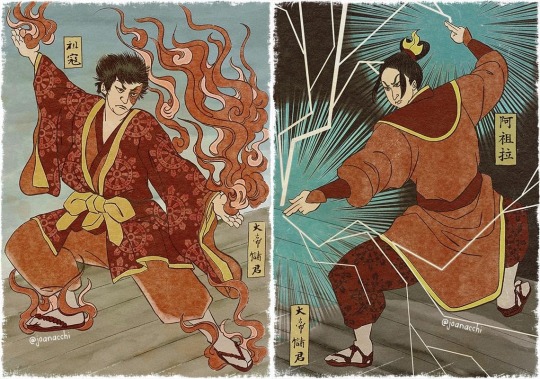
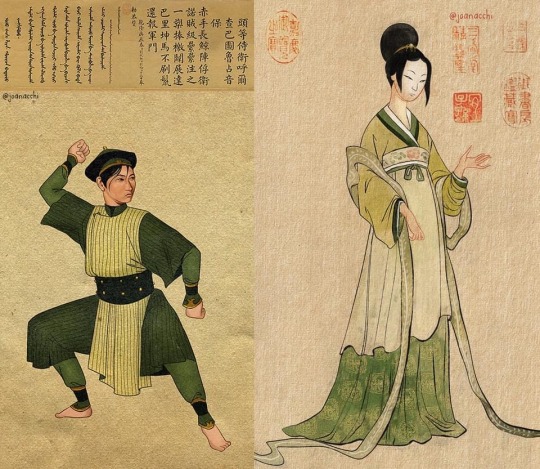
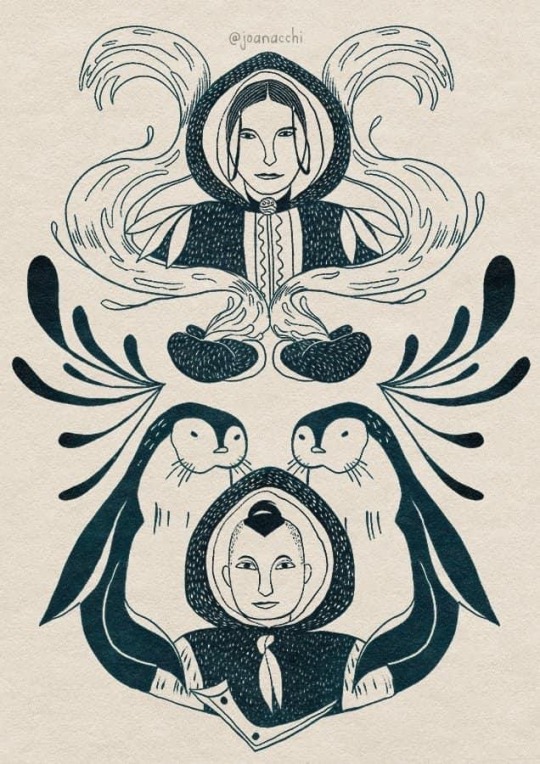
Aang: Tibetan Thangka
"Thangkas are traditional Tibetan tapestries that have been used for religious and educational purposes since ancient times! The techniques applied can vary greatly, but they usually use silk or cotton fabrics to paint or embroider on. What you can depict in a Thangka is really versatile, and I wanted to represent things that make up Aang as a character."
Zuko and Azula: Japanese Ukiyo-e
"Ukiyo-e is a style that has been around Japan between the 17th and 19th century, and focused mainly in representing daily life, theater(kabuki), natural landscapes, and sometimes historical characters or legends!
Ukiyo-e was developed to be more of a fast and commercial type of art, so many drawings we see are actually woodblock prints, so the artist could do many copies of the same art!
I based my Zuko and Azula pieces on the work of Utagawa Kuniyoshi (1798-1861) one of the last ukiyo-e masters in Japan! He has a specific piece which featured a fire demon fighting a lord that fought back with lighting, and that really matched Zuko and Azula's main techniques!”
Toph: Chinese Portraiture from Ming and Qing Dynasties
"Ming Dynasty (1368-1644) was one of the longest in China! It was also a period where lots of artistic evolutions were happening, especially when it comes to use of colour! There was not a predilection for portraits during this time, but there are a lot of pieces depicting idealized women and goddesses from the standards of the time. For this portrait of Toph, I imagined something that maybe their parents commissioned, depicting a soft and delicate Toph which we know is not what she is about ♥️
Qing Dynasty (1644-1912) was the last Chinese Dynasty to reign before the Revolution. One of the most famous emperors of this period was Qianlong, and he really liked Western art! He commissioned a lot of portraits of his subordinates, and I chose a portrait of one of his bodyguards as a reference for the second Toph portrait, which I believe is much more like how she would want to be represented! The poem on top talks about the bodyguards' achievements during a specific war. I had no time to come up with a poem for Toph, so I just used the same one for the composition!”
Sokka and Katara: Inuit Lithograph
"For a long time, Inuit art expressed itself in utilitarian ways. The Nomadic lifestyle of early Inuit tribes played a huge part in that: most art pieces are carved in useful tools, clothing, or children's toys, small and easy to be transported, and depicted scenes and patterns representing their daily lives!
That changed a lot during the colonization. Since the settling of the Inuit tribes, many art pieces began to be created in order to be exported to foreigns, so they started to sculpt bigger and more decorative pieces.
Lithography, which is a type of printmaking, was introduced to Inuit people by James Houston, that learned the technique from the japanese. The art form was quickly embraced by the inuit, as part of the process is very similar to carving. Prints that are produced by inuit artists are still being sold today!
As lithography is not an old art style and it's still commercially relevant to the Inuit communities, since creating these in 2021 I have been donating regularly to the Inuit Art Foundation, not only all the money I get from selling some prints of these but a bit more, at least once a year. Hopefully, I can increase donations this year!”
691 notes
·
View notes
Text

Tsherin Sherpa — Three’s Not Always A Crowd (highland tibetan wool, chinese silk, cotton warp and weft, 2022)
159 notes
·
View notes
Text
Interesting Topics to Research On for Bored AF People (desi version)
The Bengal Sultanate
Dominance of taka in Silk Route Trade
Tibetan Buddhism
Chamba Rumal
Pashupati Seal
Zeb-un-nissa Begum
Rasa theory of Natyashastra
Gargi-Yajnavalkya Dialogue
Saraswati (River and Goddess)
Rudraveena
Atman-Brahman Relation and Mahavakyas
70's Bollywood fashion
Paintings of Raja Ravi Varma
Dhrupad
History of Chai/Cha
Mother Goddess Mohenjo Daro
Chanakya
Prakrit Language
Baro-Bhuiyan
Chicankari
Brajabuli
Tantra
Shipton–Tilman Nanda Devi expeditions
Banaras
Annamalaiyar Temple
Chola Dynasty
Pala Empire
Terracotta Temples of Bengal
#desiblr#desi#desi tag#desi tumblr#desiposting#desi humor#being desi#desi academia#nerd stuff#school#desi history#pop culture#bollywood songs#hindustani classical music#the nerd speaks#trust me this works#best way to start the day
745 notes
·
View notes
Text

Avalokiteśvara
‘Chenrezig Bodhisattva’
Talon Abraxas
Oṃ Mani Padme Hūṃ / Om Mani Padme Hum
Chenrezig, also known as Avalokitesvara, “One who looks with unwavering eye,” is the most revered of all Bodhisattva, embodying the compassion of all Buddhas. He listens to the prayers of all sentient beings in times of challenge and difficulty. In one prominent Buddhist story, Chenrezig vows never to rest until he has helped free all sentient beings from samsara, but despite his best efforts, his task is overwhelming. So in his effort to reach out to so many cries of suffering, his arms are shattered into pieces, making them many, to better reach out to those in need. Sometimes Chenrezig visualized with eleven heads and a thousand arms fanned out around him. Tibetan Buddhism relates Chenrezig to the six-syllable mantra, Om Mani Padme Hum, and when this mantra is spoken aloud or in silence, it invokes his benevolent power and intervention. Chenrezig is consider the patron of Tibet, and, in fact, the living Buddha, the Dali Lama, is an incarnation of him.
When ever we are compassionate, or feel the love of another directed as you, be they human or animal, we experience a taste of our connection with Chenrezig.
His two front hands are in a devotional gesture, clasped in front of his jewel-draped heart. His upper right hand holds his special symbol, a crystal akshamala, or rosary, symbol of the never-ending cycle. While his left hand holds a white lotus, signifying that he frees the sentient beings from the muddy waters of suffering and hellish realms to the pure states of enlightenment. He is draped in silk garments, both legs in the “diamond pose” of mediation, and seated on a row of lotus petals.
“Bodhisattva,” literally meaning “enlightenment ('bodhi’) being ('sattva’)” in Sanskrit, has two primary meanings in Buddhism. One of them, held by the Theravada and by some Mahayanists, is of someone who is dedicated to becoming a Buddha. The other, held by some Mahayanists, is of someone who deliberately refrains from becoming enlightened, a Buddha, in order to help others.
Great Compassion Mantra: Purification, healing and protection, the Maha Karuna Dharani Sutra — benefiting all beings
30 notes
·
View notes
Note
there was Chinese interest in the Out Of Asia theory, in both the Republic, Chiang Republic and People’s Republic periods before the Out Of Africa theory became commonly accepted. Was the 1954 Yeti expedition done just from the Nepalese-Indian side or were the American agents and “anthropologists” given access on the Sino-Tibetan side of the Himalayan border?
During the early part of this century, it was absolutely believed for a long time that the deserts of Western China were the most likely place of human origins, as seen in this migration map from 1944, made from the best available knowledge of the time:
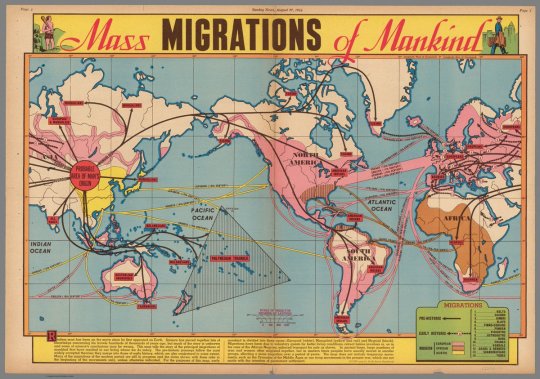
Remember, the oldest fossil remains at this point were in China, where Homo erectus was discovered (originally known by his initial place of discovery in Chungkotien Cave, nicknamed "Peking Man"). The discovery of Australopithecus and Homo habilis in Olduvai Gorge and South Africa, which place human origins in Africa, were not until the 50s and 60s, so it seemed entirely reasonable that Homo sapiens evolved in Western China.
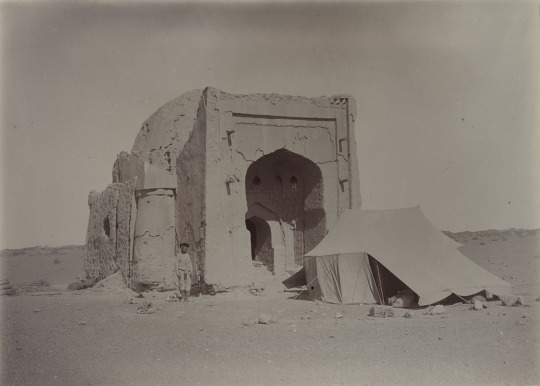
The idea that China's desert regions were the origin of modern humans and culture is seen a lot in pop culture from 1900-1950, mainly because there were tremendous explorations in the region, especially Aurel Stein's expedition of 1908, who ventured into the Taklamakan Desert to find the Dunhuang Caves and Khara-Khoto, a city destroyed completely by Genghis Khan and vanished in the desert.
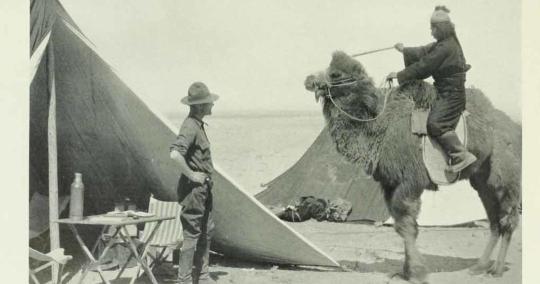
If you've ever heard of Roy Chapman Andrews and his famous expeditions in the 1920s, it's worth noting that he ventured into the Gobi Desert looking for human remains....not dinosaurs, and the discovery of dinosaur eggs was an unexpected surprise.
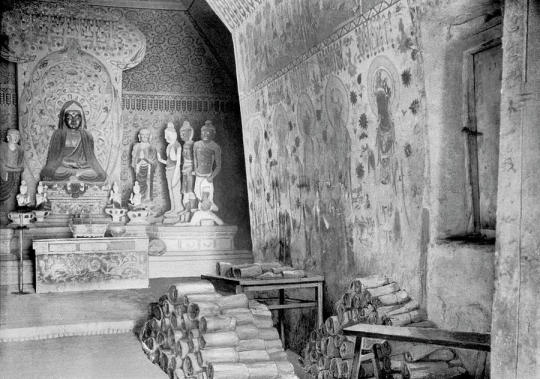
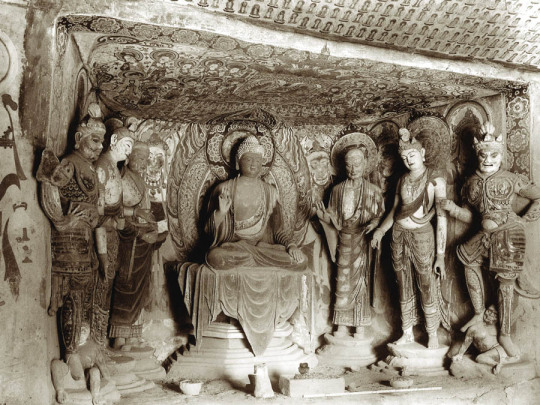
For that reason, there was a short lived Silk Road Mania that seemed to be a smaller scale predecessor to the pop culture dominating Egyptomania of the 1920s. It's bizarre to read adventure and fantasy fiction of the 1910s-1920s that features mentions of Silk Road peoples like the Kyrgyz, Sogdians, Tajik, Uigurians, and Tuvans. The best example I can think of would be the Khlit the Kossack stories of Harold Lamb (who also wrote a biography of Tamerlane), which together with Tarzan and Tros of Samothrace, formed the core inspiration for Robert E. Howard's Conan the Barbarian.
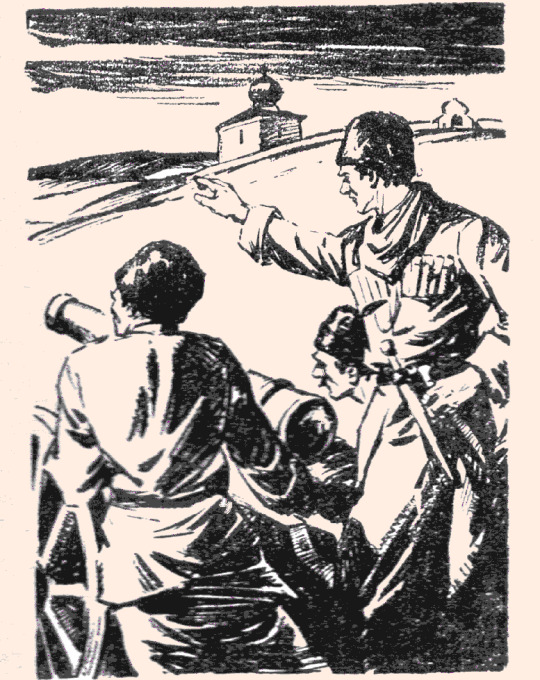
The most interesting example of this would be A. Merritt's Dwellers in the Mirage, which featured a lost city in Xinjiang that was the home of the Nordic race, who worshipped their original religion, the kraken-like squid devil god Khalkru. It was widely believed in this era that Nordics emerged from Central Asia originally, and while it's easy to write this off as turn of the century racialist claptrap pseudohistory (along with Hyperborea legends), in this case, it is actually true: a branch of the Indo-European family lived in West China, and 5,000 year old redheaded mummies have been found in the region. As usual, A. Merritt was right on the money with his archeology, more so than other 1920s authors. After all, his "Moon Pool" was set around the just discovered ruins of Nan Madol, the Venice of Micronesia.

Jack Williamson's still chilling Darker Than You Think in 1948 was also set in the Silk Road/Central Asian region, as the place the race of shapeshifters emerged from, Homo magi, who await the coming of their evil messiah, the Night King, who will give them power over the human race.
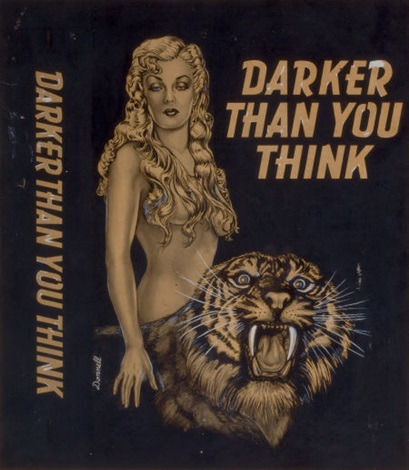
H. Rider Haggard set "Ayesha: the Return of She" (1905) in Xinjiang, among a lost Greek colony in Central Asia (no doubt based on Alexandria on the Indus, a Greek colony in modern Pakistan that was the furthest bastion of Greek Culture). This was also two years after the Younghusband Thibetan Expedition of 1903, where the British invaded Tibet. At the time, the Qing Dynasty was completely declining and lost control of the frontier regions, and the power vacuum was filled by religious authority by default (this is something you also saw in Xinjiang, where for example, the leader of the city was the Imam of Kashgar).
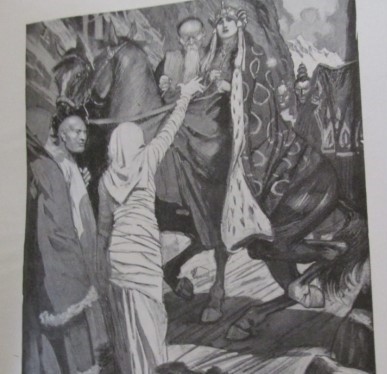
This is one of the many British invasions they have attempted to cram down the memory hole, but if you ever see a Himalayan art piece that was "obtained in 1903-1904" ....well, you know where it came from.
Incidentally, there's one really funny recent conspiracy theory about paleontology, fossils, and China that I find incredibly interesting: the idea that dinosaurs having feathers is a lie and a sinister plot spread by the Communist Chinese (who else?) to make American youth into sissy fancylads, like Jessie "the Body" Ventura. How? By lying to us and making up that the manly and vigorous Tyrannosaurus, a beast with off the charts heterosexuality and a model for boys everywhere, might have been feathered like a debutante's dress. What next - lipstick on a Great White Shark? The long term goal is to make Americans effeminate C. Nelson Reilly types unable to defend against invasion. This is a theory that is getting steam among the kind of people who used to read Soldier of Fortune magazine, and among abusive stepfathers the world over.

...okay, are you done laughing? Yeah, this is obvious crackpottery and transparent sexual pathology, on the level of the John Birch Society in the 60s saying the Beatles were a Communist mind control plot. Mostly because animals just look how they look, and if it turned out that the ferocious Tyrannosaurus had feathers and looked like a fancylad Jessie Ventura to you, well, that's your problem and mental baggage, really.
I was left scratching my head over this one. But there is (kind of) something to this, and that is that a huge chunk of recent dinosaur discoveries have been in China. I don't think it has anything to do with a Communist plot to turn American boys into fancylads, but more to do with a major push in internal public investment in sciences in that country, and an explosion of Chinese dinosaur discoveries. If you want to see a great undervisited dinosaur museum, go to the Zigong Dinosaur Museum in Sichuan.

Pop quiz: what living scientist has named more dinosaur discoveries? It's not Bakker or Horner. The greatest living paleontologist, Xu Xing, which is why a lot of recently found dinosaurs are named things like Shangtungasaurus.
250 notes
·
View notes
Text
META The King Mu of Zhou/Iron Mask Scholar Theorem

[ID Head-and-shoulders of a man in a fancy hat looking with satisfaction at a pill taken from a small box. Below him, a man in alchemist’s robes bends over a recumbent form that looks like a large jade figurine. The right side of the picture is filled with curlicule ornamentation.]
Okay okay okay, I wrote a version of this with quotes and chapter references but it’s quite long so I suspect not many people have read it. (No judgement, I know it’s long, I feel it.) But this definitely is something I want to talk about, so I’m doing a paperplane version for tumblr.
So! The very first adventure in this series, Wu Xie encounters a double-layer tomb with a (living) man wrapped in jade armour who is promptly murdered by Zhang Qiling. The closest thing we get to an explanation is:
– Lushang-wang raided a Western Zhou tomb for immortality secrets, then built his own tomb over it so he could peacefully bake in the armour for a couple of thousand years, to finish the immortality process.
– Lushang-wang murdered by his advisor, a fengshui expert named Iron Mask Scholar, who also put on the armour.
– Iron Mask Scholar killed some time later by Zhang Qiling.
– The map to this tomb is one of a set of famously-encrypted documents sometimes known as the Warring State Silk Texts or more specifically the Lu Yellow Silks, or some variant in-between.

[ID Overhead view of a sarcophagus under a great tree, with various lids and layer scattered around it, and inside – and sitting up – is a body dressed in armour made of laced-together plates of dull jade. Wu Xie etc. recoil in alarm. End ID]
Come Vol. 4 Snake Marsh Ghost City, Wu Xie explicitly identifies the author of these Lu Yellow Silks as Iron Mask Scholar. He describes him as “the Leonardo da Vinci of Lu State” who encrypted documents to get important secrets distributed against the wishes of a higher power. (This is also the book that introduces King Mu of Zhou as a relevant historical figure, in the form of a stone mural which heavily implies his account of a diplomatic visit to the Queen Mother of the West was an outright lie.)
There are some bits and bobs throughout the rest of the main book series, specifically, part of the history of the Jiumen going on a super big raid to find a whole stash of Lu Yellow Silks to decipher for secrets of immortality on behalf of their current patron. The novel version of this arc doesn’t really dig into who wrote them and focuses on the effect they had in the 20th century. The Ultimate Note version changes the author to King Mu of Zhou and brings in a story initially written for the Sand Sea novel – King Mu of Zhou obtained an immortality elixir from the Queen Mother of the West but didn’t want to stay in her country to complete the process by sleeping in jade. Instead he made jade armour of his own and… put a baby in a jade box: “He built two figurines with jade meteorite. One figurine to contain himself, with another to contain a baby. After taking the pill, he planned to break the figurine in a few years under certain conditions. He would be reborn as a baby and attain longevity.” (UN, Ep 35, iQiyi subs).

[ID A painting of a great cavern with rough pillars, with the irregular shape of what might be a meteorite in the background. In the midground are two upright lumps of jade of equal proportions. Vague shadows inside indicate an adult in the left one, and a child in the other. End ID]
Skippy skip through some Jiumen stuff and some Tibetan Sea Flower stuff that suggests Zhang Qiling was the baby in the box… we get to Sand Sea proper, in which the chief antagonists are the Wang Family, descendants of Wang Zanghai from the Ming Dynasty.
But, say the Wang Family, we didn’t start this. Actually you need to go back thousands of years to King Mu of Zhou. The drama version of this revelation is a very clipped lecture, albeit with some interesting art, which mostly focuses on the snake eyebrow copper fish and the snake pheromones etc. etc. (It’s a fair call – sometimes you just gotta focus.) The novel version is very, very long, placed in the novel where you would normally expect the big climax/plot resolution/massive multiplayer final action scene to be. Some key points:
– Wang-laoshi keeps explaining that he isn’t lying but he is leaving gaps in the story for his student to figure out.
– We go right back to the story of Lushang-wang raiding a Western Zhou tomb, this time specifying that it belonged to King Mu of Zhou himself. Also that Iron Mask Scholar incited Lushang-wang to take up graverobbing from the start. He wasn’t an opportunist but a strategic planner who provided a “ghost edict” in King Mu of Zhou’s handwriting explaining that it was totes okay to dig up his tomb, the ghost of King Mu of Zhou thought that was fine, break out the shovel, kid.
– Story interrupted by a student explaining that for the handwritten edict to exist, King Mu of Zhou must still have been alive somehow to write it. (No forgers in Ancient China.) The teacher agrees, explaining that King Mu of Zhou took the Queen Mother of the West’s immortality elixir but could not by himself find jade armour to neutralise the deleterious side effects.
– FROM THEN ON Iron Mask Scholar is not in this story. This is now a story about King Mu of Zhou manipulating Lushang-wang from the shadows, creating the mechanism of a baby in a small dragon-pattern box as a timer and synchronous key for his own coffin, creating the Lu Yellow Silks which as we know were written in the Warring States Era and explicitly attributed to the guy who hid his face all the time………
– In addition, the rather odd (but fun) movie Time Raiders also features Iron Mask Scholar as a key player, this time writing his secrets on copper tablets not silk and also creating a box which is both a timer and a key, like that dragon-pattern box attributed to King Mu of Zhou.
My Conclusion:
King Mu of Zhou and Iron Mask Scholar’s deeds were so often conflated because they were the same guy. This is the truth hinted at by Wang-laoshi and Xu Lei.
(to be continued)
22 notes
·
View notes
Text
Are you bored? Here are some random topics to research.
-Volcanoes and how they work
-Kazakh fashion trends in the 1500s
-The history of laundry detergent
-Types of algae
-How silk is made
-The genre of Dark Fantasy
-How WiFi works
-Early photography
-The Tibetan writing system
-The nearest solar system to ours
-Māori musical instruments
-Species of jellyfish
-French salon culture in the 19th century
-The nervous system
-Agriculture in Madagascar
-The relationship between plants and fungi
-Food from the Incan Empire
-The Dunning-Kruger Effect
-Concepts of time in different cultures
-Life before the dinosaurs
Happy learning!
#academia#academia aesthetic#light academia#dark academia#chaotic academia#literature#learning#study motivation#studying#knowledge#tumblr
43 notes
·
View notes
Text



Sword (jian) and scabbard, probably made in the court workshops of the Yongle Ming Emperor. Chinese, Ming Dynasty, early 15th century.
The hilt is of gilt iron. The grip is of gibbous rectangular section, punched with small circles to imitate ray skin. Down the centre of the front is a raised spine bordered by tiny flames at either side.
The pommel is of trilobed form, bordered at the front and rear by bands of golden scrolls. The front panel of the pommel is chiselled and fretted with a dragon surrounded by interlacing flames, with triple claws on each paw. At the rear of the pommel, the central panel is decorated with a monster mask (kirtimukha), surmounted by a silvered crescent and golden disc, and with human hands, also surrounded by flames. At either side of the pommel are the Eight Buddhist Emblems of Good Augury (ba jixiang): the wheel of law (dharma), the standard, the treasure jar, the pair of fish, the endless knot, the lotus, the parasol and the conch shell of victory.
The guard is embossed in the form of a monster mask, surmounted by a silvered crescent and golden disc. The face is punched with circles, the canine teeth silvered, the eyebrows and whiskers chiselled and gilt. The horns are in the form of crab claws. At either side of the mouth is a paw in the form of a human hand. The head is surrounded by scrolling curls of mane. The rear of the guard is rendered as the underside of the jaw, with a set of silvered teeth, and a narrow beard running into a throat of alternate silvered and gilt bands.
The blade is associated but is probably a later replacement of Tibetan manufacture. It is formed of pattern-welded steel, of diamond section, straight and double edged. The pattern welding produces a mirrored pattern of addorsed crescents at either side of the medial ridge. The tang is of rectangular section, tapering towards the pommel, with a large expanded peg-hole towards the end. The edges have been ground and sharpened.
The scabbard is of wood covered in green stained leather and bound with gilt iron. At the throat is a V-shaped cut out at the front for seating the blade, and a scalloped cut-out in the leather to accommodate the guard. The throat retains traces of the scarlet silk with which it was lined. The iron binding comprises a long, facetted strip running all the way round either edge.
There are eight transverse bands at the rear, the uppermost and fourth of which are wider than the others, and extend round the front of the scabbard forming suspension loops. The edging strip has four main facets, with an additional narow facet at either side. It is decorated with scrollwork in gold running down each facet, and matching that on the pommel. At either end is a set of three golden lotus leaves.
The front panel is divided stylistically into upper and lower sections. The upper section is decorated quite plainly; a series of five beaded transverse bands divide it into six sections, and there are three vertical bands of fretted four-petalled rosettes in each section.
At the throat is a cusped section with a beaded border, below which is a band of flames. The ornate lower section has six smaller segments, divided vertically and horizontally by fretted 'vajras', each with a 'yinyang' symbol in the central knop. The half-'vajras' at either side emanate from the heads of lions, and the vertical bands of decoration at either side are formed by rows of flames.
Above and in the middle of these divisions are two square panels, each containing a cusped lozenge shaped central medallion, the corners decorated with interlacing flames. The uppermost of these two panels contains two dragons intertwined amid flames, with the heads at top right and bottom left; the lower has two similar dragons, with thicker bodies, and with their heads confronted at the left and right.
The chape section is decorated with a large panel of interlacing flames, within a beaded border. At the rear of the scabbard, the upper band is decorated with alternating gold and silver scrollwork, and terminates in a rosette at the front. The next two narrow bands are decorated with silver scrollwork only. The fourth is decorated at the rear like the top one, but is extended accross the front in a broad band; it is chiselled with four medallions decorated with gilt characters on silver grounds, and surrounded by interlacing gilt flames. The three lower bands are decorated in gold scrollwork.
The rear chape panel has a small, flat piece of rather coarse, scrolling interlace at the bottom, and narrow bands of petalled rosettes at either side.
A four character Tibetan inscription on the lower suspension loop reads 'khi'u ga ral gri' (honourific sharp sword).
China, 15th century (About 1420),
Leather, Ferrous, Gold, Silver, Semi-precious stone, Silk, Wood,
Dimensions:
Blade Length: 30 inches
Overall (sword) Length: 35 inches
Courtesy: Royal Armouries Museum, Leeds, United Kingdom
Sword (jian) and scabbard, probably made in the court workshops of the Yongle Ming Emperor. Chinese, Ming Dynasty, early 15th century.
#art#history#design#style#sculpture#silver#gold#semi precious stones#royal armouries#leeds#silk#wood#sword#jian#scabbard#ming#15th century#yongle#imperial
52 notes
·
View notes
Text

Sgra-Snyan
Tibetan, 14th–16th century
The ancient "silk route", running from the Mediterranean to Sian in east central China, made Central Asia a meeting place of many cultures. This lute, an extraordinary example of musical exchange between East and West, is similar to instruments played by angels depicted in seventh-century Buddhist cave paintings. It offers some insight into the development of the modern sgra-snyan. The body, with two skin-covered chambers, is a rare example of an archaic transitional form that seems to point to the Afghan robab, and various Himalayan lute types. Decorative elements, such as green-colored skins, like those of the damarn, and the portraits of Buddha and musicians, rendered on painted ivory with gold leaf, are typical of fifteenth-century Tibet. The back, fingerboard, and pegbox reveal cartouches and palmettes reminiscent of seventeenth-century Persia.
39 notes
·
View notes
Text
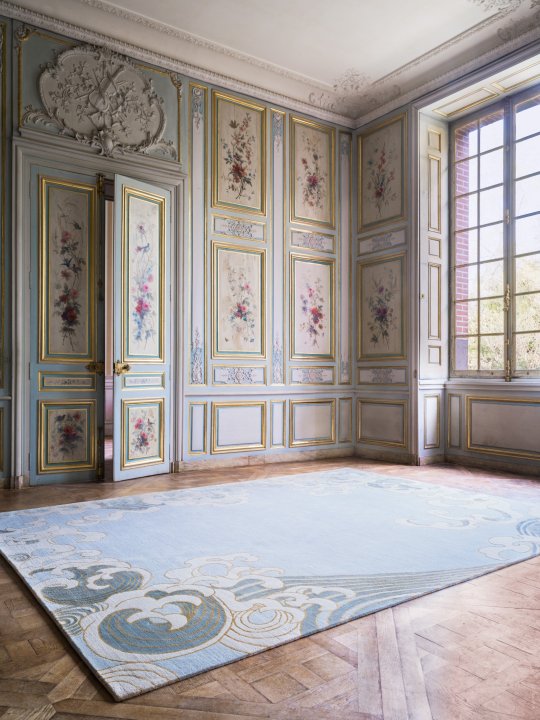

Tempest Day Rug from the Opulent Nature Collection by Guo Pei. Handknotted Tibetan wool and silk. (From $6, 000). (Hi-Res 1, 2).
#art#rug#rugs#floor covering#floor coverings#guo pei#opulent nature#collection#collections#tibet#tibetan#design#decor#handmade#handknotted#silk#wool#tibetan silk#tibetan wool#therugcompany
1 note
·
View note
Text

Yang Guifei by Uemura Tsune 1922. Shohaku Art Museum, Nara, Japan.
Yang Guifei was one of the Four Beauties of China. She was also one of the victims of the era of the An Lushan rebellion, an eight year civil war that radically transformed China from a tolerant nation to an anti-foreigner one. An Lushan was a Turkic rebel that had served as a general in Tang China. He bore a Sogdian name, likely due to childhood adoption by a Sogdian step-father that had wed his Turkic mother from the elite Ashide clan. He was also adopted by Chinese consort Yang Guifei. Though, because Yang Guifei's cousin feuded with An Lushan prior to his rebellion the Tang emperor's soldiers sought her execution. They accused her cousin of causing An Lushan to rebel and also accused him of treason via conspiracy with the Tibetans. The Tang emperor sat idle while the soldiers killed his favorite consort, fearful they would depose him if he defended her too fiercely. Her family was also killed, regardless of their innocence:
"When tourists go to Huaqing Springs in Xi’an today, they can bathe in hot water as she allegedly did when the aging Emperor first saw her among the court women. She is said to have formed a friendship with An Lushan, who became a general of Chinese troops despite his Central Asian origins; she may have even adopted An Lushan as a son. Both Yang Guifei and An Lushan are described as dancing the “whirl,” a Central Asian dance which can be seen in pictures of the Tang court preserved in Dunhuang’s caves on the Silk Road. The Emperor is believed to have been so in love with Yang Guifei, he neglected his duties. The location of Yang’s death is as famous as that of her bath; guidebooks will tell you exactly the location of Ma Lei Station, the place where she was throttled, hanged, or forced to commit suicide by the Emperor’s disgruntled associates." (taken from Columbia.edu)
"In this tense situation, soldiers of the imperial guard declared that Yang Guozhong was planning treason in collaboration with the Tibetan emissaries. They killed Yang Guozhong, his son Yang Xuan (楊暄), Consort Yang's sisters, the ladies of Han and Qin, and Wei Fangjin. (Wei Jiansu was severely injured and nearly killed, but was spared at the last moment.) Yang Guozhong's wife Pei Rou (裴柔) and his son Yang Xi (楊晞), along with Consort Yang's sister, the Lady of Guo, and her son Pei Hui (裴徽) tried to flee, but were killed. The soldiers then surrounded Emperor Xuanzong's pavilion and refused to leave, even after the Emperor came out to comfort them and ordered them to disperse. Emperor Xuanzong then sent Gao Lishi to ask General Chen Xuanli for his advice. Chen's reply was to urge the Emperor to put Consort Yang to death." (taken from Wikipedia)
#ancient china#tang dynasty#chinese history#japanese art#ancient history#history#art#paintings#museums
28 notes
·
View notes
Text
MLQC CN Victor - Ethnic Style Theme
Base on the title of the Victor's date, I knew that he and Mc visit Luolan.

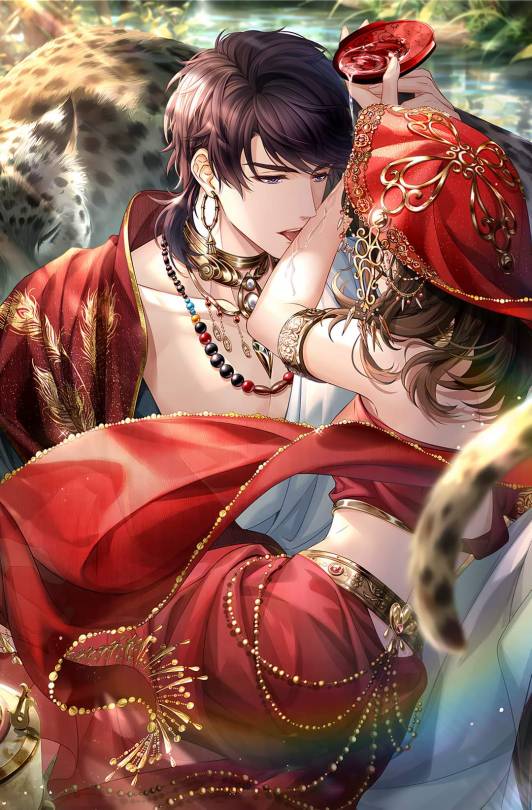
Loulan, also called Krorän or Kroraina, Uyghur was an ancient kingdom based around an important oasis city along the Silk Road already known in the 2nd century BCE on the northeastern edge of the Lop Desert.
You can see Victor's always connects with camel, he also brings a camel here.

And Lucien? He dresses up in Tibetan costume, with the White Pagoda in the background.
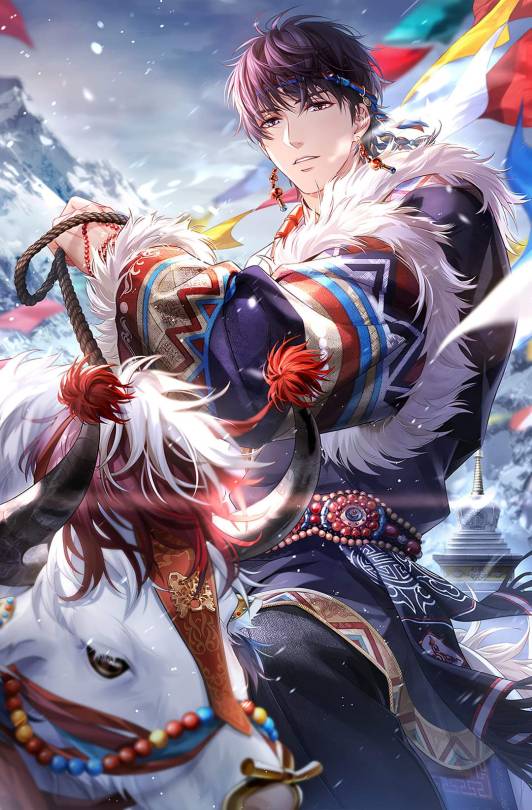

He is accompanied by a Tibetan antilope (a zangling goat).

Gavin, Kiro, and Shaw are here
56 notes
·
View notes
Text

Green Tara ॐ
Tara’s name is derived from the Sanskrit root tṛ, which means “to traverse” or “to cross.” Tara guides and protects us as we journey across the ocean of the suffering of cyclic existence and arrive at the shore of enlightenment. In Tibetan, she’s known as Jetsun Drölma. Jetsun means “noble, revered” and Drölma means “she who liberates.” Tara is the noble one who liberates us from the ocean of suffering.
She arises in many forms of varying colors and demeanors, each of which has a specific way of supporting us on the path to liberation. Green Tara is a principal form of Tara whose activity is to remove obstacles and protect us from fear and danger. Green Tara has an entourage of twenty-one forms, each of which protects us from a specific type of fear, danger, and calamity.
In Vajrayana Buddhism, various colors represent different facets of awakened awareness and how we experience them on an ordinary level. The color green is associated with enlightened activity, wisdom, and compassion in action. So Green Tara is the embodiment of enlightened activity; her unimpeded action is instantly and precisely attuned to the needs of each moment. She knows just what’s needed to facilitate our liberation. Green is also associated with the wind element, and Tara’s green form expresses her unwavering commitment to act for the benefit of beings with the swiftness of the wind.
Beyond her color, every aspect of Green Tara’s appearance is imbued with meaning. Her boundless, unbiased generosity, joyful diligence, patience, ethical conduct, concentration, and wisdom adorn her as fine silks and jewel-encrusted earrings, necklaces, and bangles. Her golden crown expresses her realization of the five disturbing emotions as being wisdom in their essence. Her black hair is partially drawn into a topknot symbolizing that she’s attained full realization, while the rest of her hair flows down her shoulders and back indicating her commitment to benefit all beings mired in suffering.
How to do Green Tara Practice
1. Take Refuge
Find a quiet place to sit and settle into a posture that allows you to be alert yet relaxed. Take several breaths. Let go of any thoughts or concerns and welcome the present moment. When settled, take refuge in all awakened beings and your innate basic goodness by reciting: “Until awakening I take refuge in the Buddha, dharma, and noble sangha. By the merit of my acts of generosity and other awakening qualities, may I attain full awakening for the benefit of all beings.”
2. Visualize Tam Turning into Tara
With eyes open, gaze into the sky in front of you, taking in the openness of space with a sense of receptivity. Visualize that unconditioned compassion emerges from that openness in the form of a green Tam, the mystical seed syllable associated with Tara. (See the script on top of the lotus at right.) The Tam instantly transforms into Green Tara who sits upon a luminous disk of the moon atop a fully blossomed lotus. Her body is made of blue-green light, the color of a clear, alpine lake. Like a rainbow, she appears, yet her form is not substantial.
3. Empower Your Visualization
Visualize rainbow-colored light radiating out from your heart. It purifies the world, makes offerings to the awakened ones, and invokes Green Tara’s wisdom and compassion to be present with you. In response, many forms of Tara rain down and dissolve into the Green Tara that you originally visualized, empowering your visualization. Have confidence that all your teachers’ mind streams are united with hers and that she’s truly present in the sky in front of you.
4. Chant Green Tara’s Mantra
Begin to chant Tara’s mantra Om Tare Tu Tare Ture Svaha as a way to connect directly with her. The mantra is Tara’s wisdom and compassion manifesting as sound and vibration. Feel the vibration of the mantra in your body and feel that resonate with Tara’s body. As you chant the mantra, visualize that a stream of wisdom-awareness nectar begins to flow from her open right hand. It’s like liquid light that’s blue-green in color. This river of nectar flows into the crown of your head and removes all fear, gives protection, removes obstacles and obscurations, and transmits awakened awareness to you and all beings. Make any prayers to Green Tara that you would like, and allow yourself to receive her blessing.
5. Know That You Are Tara
See Green Tara dissolve into light and that light dissolve into you. As it enters your body, it illuminates you from the inside out, and your ordinary body now arises in the form of Green Tara. Experience your blue-green body of light as being emptiness and form inseparable. Your awakened qualities adorn you as silks and jewels. Your hands and legs rest in the same gestures and manners as hers. Experience your mind as being inseparable from Green Tara’s mind. In your heart area is a blue-green Tam. As you continue to chant the mantra, light radiates out from your heart, sending joy, compassion, loving-kindness, strength, and equanimity to all beings without exception.
6. Dissolve the Visualization
When you’re done reciting the mantra, take a moment to sit and feel the impact. Then, gradually dissolve the visualization until there’s just a drop of blue-green light left in your heart center, radiating brilliantly the essence of your true nature. Then the light dissolves into space, like a rainbow disappearing into the sky. Rest your mind naturally for a few minutes or longer.
7. Share the Benefit
End this practice session by sharing with all beings any benefit that came from your connecting with Green Tara. Do this by reciting: “Through this goodness may awakening spontaneously arise in our streams of being. May all obscurations and distortions fall away. May all beings be liberated from suffering and the stormy waves of birth, sickness, old age, and death.”
Green LOTUS Tara
--Mahaboka
6 notes
·
View notes
Text
The Chariots Roll[1]
By Du Fu (712 - 770)
Chariots rumble, horses neigh,
Conscripts with bows and arrows at their waists stay.
Parents, wives, children, all run out to wave goodbye,
Xianyang Bridge[2] shrouded in dust, hides away.
Clothes gripped, feet stomp, they block the way,
Their wails ascend, piercing through the cloudy day.
A passerby[3] by the roadside queries a conscripted man,
The man responds, “Drafts continue without end.
From fifteen, we march north to guard the river's bend,[4]
Until forty, we till the fields of the western land.[5]
Our lizheng wrapped our heads as we departed,[6]
Returning with white hair, we guard the border still.
The border outposts bleed, an ocean charted,
Yet the Martial Emperor's thirst for expansion remains unfulfilled.[7]
Sir, have you not heard of Han’s provinces east of the mountains,[8] two hundred strong,
Where thousands of villages and hamlets, brambles and thorns belong.
Though strong women wield hoes and ploughs with might,
The fields' crops grow wild, chaos in sight.
And the soldiers of Qin, in battles they brave,
Driven like dogs and chickens, no difference in their fate.
Though you, elder, may inquire with care,
Can a conscript dare voice his despair?
In this winter, west of the Pass,[9]
Soldiers still await their rest.
County officials demand their share,
But whence do taxes and rents flare?
Know that bearing a son brings distress,
While having a daughter is a prize blessed.
A daughter, at least, can wed a neighbor,
But a son will be buried among the hundred grasses.
Sir, have you not seen Qinghai's edge so vast?
Through the ages, white bones untouched and cast.
New ghosts mourn, old spirits weep,
In the mist and rain, their cries seep, wailing, wailing.”
[1] The Chariots Roll, written by Du Fu (712-770) during the Tianbao period (742-756) of the Tang Dynasty, likely in 751, captures a turbulent era marked by the Tang Empire's frequent military campaigns against ethnic minorities in the southwestern regions. In 751, under the command of General Xianyu Zhongtong, an army of 80,000 suffered a devastating defeat at the hands of Nanzhao, resulting in the loss of 60,000 soldiers. To replenish the severely diminished forces, the principal chancellor, Yang Guozhong, initiated an impressment campaign, involving the coercive drafting of civilians, who were bound in chains and sent to military camps. This poem poignantly reflects the harsh realities and human suffering brought about by these historical events.
[2] The Xianyang Bridge was built by Emperor Wu of the Han Dynasty. It was located southwest of present-day Xianyang City in Shaanxi Province. It served as a vital route for travel from Chang'an to the northwestern regions.
[3] Refers to Du Fu himself.
[4] During the 750s, the Tang Dynasty frequently clashed with the Tibetan Empire. Tang troops from the Longyou, Guanzhong, and Shuofang regions were strategically stationed west of the Yellow River to defend against Tibetan incursions.
[5] Under the tuntian system, troops were sent to harsh frontier landscapes with the objective of transforming uncultivated land into self-sustaining agrarian settler colonies. This was also a measure to defend against Tibetan incursions.
[6] In the Tang Dynasty, for every one hundred households, an official called lizheng (里正) was appointed. The lizheng was responsible for managing household registrations, overseeing civil affairs, and urging the completion of tax and labor duties. Young recruits needed the assistance of a lizheng to wrap their heads with a three-chi-long black silk.
[7] In Tang poetry, it was common to use "Han" as a euphemism for the Tang Dynasty. Therefore, the term "Martial Emperor" (or Emperor Wu of Han) is used to refer to Emperor Xuanzong of the Tang Dynasty. "Han" in the following line also refers to the Tang Dynasty.
[8] Mount Xiao and Mount Hua.
[9] The Hangu Pass.
兵车行
杜甫
车辚辚,马萧萧,行人弓箭各在腰。
耶娘妻子走相送,尘埃不见咸阳桥。
牵衣顿足拦道哭,哭声直上干云霄。
道旁过者问行人,行人但云点行频。
或从十五北防河,便至四十西营田。
去时里正与裹头,归来头白还戍边。
边庭流血成海水,武皇开边意未已。
君不闻汉家山东二百州,千村万落生荆杞。
纵有健妇把锄犁,禾生陇亩无东西。
况复秦兵耐苦战,被驱不异犬与鸡。
长者虽有问,役夫敢申恨?
且如今年冬,未休关西卒。
县官急索租,租税从何出?
信知生男恶,反是生女好。
生女犹得嫁比邻,生男埋没随百草。
君不见,青海头,古来白骨无人收。
新鬼烦冤旧鬼哭,天阴雨湿声啾啾!
7 notes
·
View notes